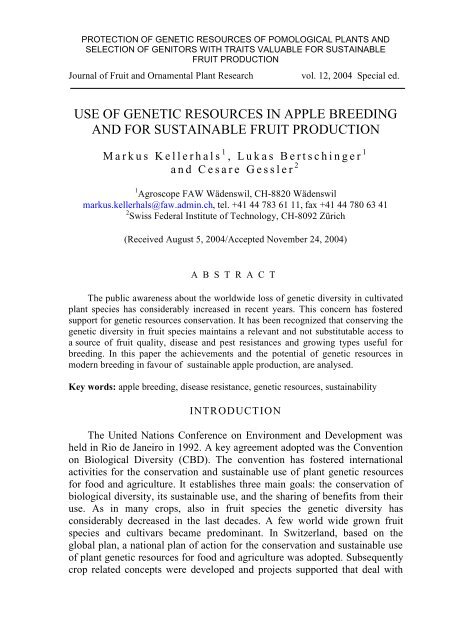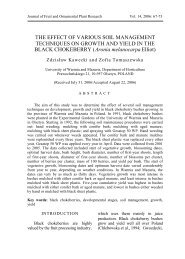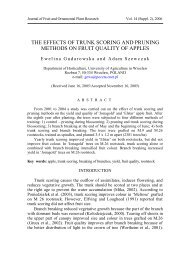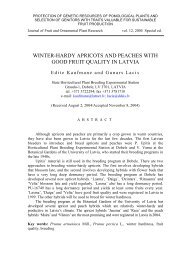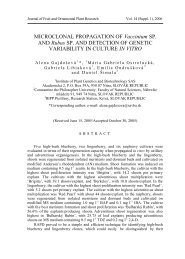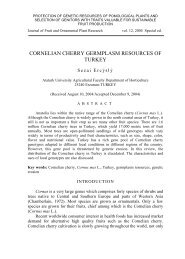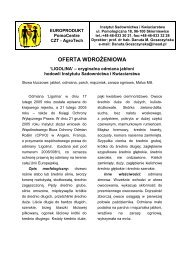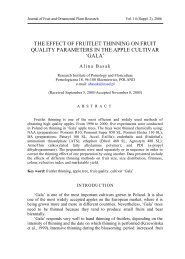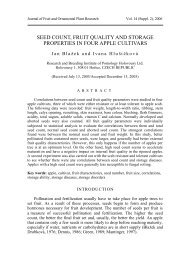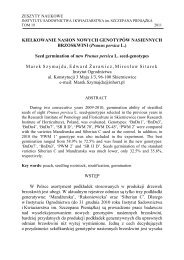Use of genetic resources in apple breeding and for sustainable fruit ...
Use of genetic resources in apple breeding and for sustainable fruit ...
Use of genetic resources in apple breeding and for sustainable fruit ...
Create successful ePaper yourself
Turn your PDF publications into a flip-book with our unique Google optimized e-Paper software.
PROTECTION OF GENETIC RESOURCES OF POMOLOGICAL PLANTS ANDSELECTION OF GENITORS WITH TRAITS VALUABLE FOR SUSTAINABLEFRUIT PRODUCTIONJournal <strong>of</strong> Fruit <strong>and</strong> Ornamental Plant Researchvol. 12, 2004 Special ed.USE OF GENETIC RESOURCES IN APPLE BREEDINGAND FOR SUSTAINABLE FRUIT PRODUCTIONMarkus Kellerhals 1 , Lukas Bertsch<strong>in</strong>ger 1<strong>and</strong> Cesare Gessler 21 Agroscope FAW Wädenswil, CH8820 Wädenswilmarkus.kellerhals@faw.adm<strong>in</strong>.ch, tel. +41 44 783 61 11, fax +41 44 780 63 412 Swiss Federal Institute <strong>of</strong> Technology, CH8092 Zürich(Received August 5, 2004/Accepted November 24, 2004)ABSTRACTThe public awareness about the worldwide loss <strong>of</strong> <strong>genetic</strong> diversity <strong>in</strong> cultivatedplant species has considerably <strong>in</strong>creased <strong>in</strong> recent years. This concern has fosteredsupport <strong>for</strong> <strong>genetic</strong> <strong>resources</strong> conservation. It has been recognized that conserv<strong>in</strong>g the<strong>genetic</strong> diversity <strong>in</strong> <strong>fruit</strong> species ma<strong>in</strong>ta<strong>in</strong>s a relevant <strong>and</strong> not substitutable access toa source <strong>of</strong> <strong>fruit</strong> quality, disease <strong>and</strong> pest resistances <strong>and</strong> grow<strong>in</strong>g types useful <strong>for</strong>breed<strong>in</strong>g. In this paper the achievements <strong>and</strong> the potential <strong>of</strong> <strong>genetic</strong> <strong>resources</strong> <strong>in</strong>modern breed<strong>in</strong>g <strong>in</strong> favour <strong>of</strong> susta<strong>in</strong>able <strong>apple</strong> production, are analysed.Key words: <strong>apple</strong> breed<strong>in</strong>g, disease resistance, <strong>genetic</strong> <strong>resources</strong>, susta<strong>in</strong>abilityINTRODUCTIONThe United Nations Conference on Environment <strong>and</strong> Development washeld <strong>in</strong> Rio de Janeiro <strong>in</strong> 1992. A key agreement adopted was the Conventionon Biological Diversity (CBD). The convention has fostered <strong>in</strong>ternationalactivities <strong>for</strong> the conservation <strong>and</strong> susta<strong>in</strong>able use <strong>of</strong> plant <strong>genetic</strong> <strong>resources</strong><strong>for</strong> food <strong>and</strong> agriculture. It establishes three ma<strong>in</strong> goals: the conservation <strong>of</strong>biological diversity, its susta<strong>in</strong>able use, <strong>and</strong> the shar<strong>in</strong>g <strong>of</strong> benefits from theiruse. As <strong>in</strong> many crops, also <strong>in</strong> <strong>fruit</strong> species the <strong>genetic</strong> diversity hasconsiderably decreased <strong>in</strong> the last decades. A few world wide grown <strong>fruit</strong>species <strong>and</strong> cultivars became predom<strong>in</strong>ant. In Switzerl<strong>and</strong>, based on theglobal plan, a national plan <strong>of</strong> action <strong>for</strong> the conservation <strong>and</strong> susta<strong>in</strong>able use<strong>of</strong> plant <strong>genetic</strong> <strong>resources</strong> <strong>for</strong> food <strong>and</strong> agriculture was adopted. Subsequentlycrop related concepts were developed <strong>and</strong> projects supported that deal with
M. Kellerhals et al.the objectives <strong>of</strong> the plan <strong>of</strong> action. The steps <strong>in</strong>clude an <strong>in</strong>ventory <strong>of</strong> the<strong>resources</strong> still available, their conservation, characterization <strong>and</strong> use.Breed<strong>in</strong>g strategies are most <strong>of</strong>ten consider<strong>in</strong>g the most advancedselections <strong>and</strong> cultivars <strong>and</strong> thus lead<strong>in</strong>g to a narrow <strong>genetic</strong> basis. The<strong>in</strong>trogression <strong>of</strong> traditional varieties <strong>and</strong> accessions <strong>of</strong> the genepool is <strong>of</strong>tenfeared due to undesirable characteristics that might be <strong>in</strong>corporated. However,there is scope <strong>for</strong> consider<strong>in</strong>g a wider <strong>genetic</strong> basis <strong>in</strong> <strong>apple</strong> breed<strong>in</strong>g <strong>for</strong>susta<strong>in</strong>able <strong>fruit</strong> production.Breed<strong>in</strong>g aimsModern breed<strong>in</strong>g aims <strong>in</strong> <strong>apple</strong> (Malus x domestica Borkh.) aredeterm<strong>in</strong>ed by market <strong>and</strong> consumer requirements. The markets become more<strong>and</strong> more <strong>in</strong>ternational. This leads to the cultivation <strong>of</strong> world <strong>apple</strong>s such as‘Golden Delicious’, ‘Gala’, ‘Fuji’ <strong>and</strong> ‘Braeburn’. Besides, additionalcultivars that are locally produced <strong>and</strong> desired by consumers especially <strong>in</strong>periurban grow<strong>in</strong>g zones, are available. As part <strong>of</strong> susta<strong>in</strong>able systems,cultivars need to satisfy economical <strong>and</strong> ecological dem<strong>and</strong>s. S<strong>in</strong>ce marketm<strong>and</strong>ate, new <strong>and</strong> successful cultivars must be superior <strong>in</strong> some specific traitsthan the presently marketed ones. This means that they must be dist<strong>in</strong>ctive<strong>and</strong> improved with respect to <strong>in</strong>tr<strong>in</strong>sic <strong>and</strong> extr<strong>in</strong>sic quality aspects. Foraddress<strong>in</strong>g ecological concerns, there is an <strong>in</strong>tensive ef<strong>for</strong>t to develop diseaseresistant high quality cultivars. Disease resistant varieties allow a significantreduction <strong>of</strong> pesticide <strong>in</strong>puts <strong>in</strong> orchards <strong>in</strong> temperate climates wherecompared to other crops more treatments are needed (e.g. Fried et al., 1992).Such cultivars grown <strong>in</strong> adapted <strong>and</strong> susta<strong>in</strong>able systems could furtherimprove the image <strong>of</strong> <strong>apple</strong>s be<strong>in</strong>g a healthy food <strong>and</strong> contribute to high foodsafety. However, none <strong>of</strong> those disease resistant cultivars has yet achieveda breakthrough <strong>in</strong> the marketplace comparable to varieties such as ‘GoldenDelicious’, ‘Gala’ or ‘Braeburn’. The success <strong>of</strong> disease resistant varieties atthe po<strong>in</strong>t <strong>of</strong> sale is not related to their attribute ‘disease resistant’. Thesuccessful <strong>in</strong>troduction <strong>of</strong> a new cultivar is primarily determ<strong>in</strong>ed bywholesalers <strong>and</strong> retailers, <strong>and</strong> these refer to consumer needs, as they perceivethem, relat<strong>in</strong>g to <strong>fruit</strong> quality <strong>and</strong> a respective market<strong>in</strong>g strategy. A recentconsumer test per<strong>for</strong>med by Agroscope FAW Wädenswil <strong>in</strong> a localsupermarket revealed <strong>fruit</strong> quality criteria to be more important to consumersthan the attribute ‘from organic production’ (Tab. 1).Table 1. Importance <strong>of</strong> different quality <strong>and</strong> production criteria to consumers <strong>in</strong>a survey <strong>in</strong> Switzerl<strong>and</strong>, June 2004, 200 consumers, <strong>in</strong> percentFirmness Crispness Flavour Organic productionNot important 10 6 5 57Important 51 43 47 25Very important 39 51 48 1854J. Fruit Ornam. Plant Res. Special ed. vol. 12, 2004: 5362
M. Kellerhals et al.resistances <strong>in</strong> a cultivar. Examples <strong>for</strong> molecular selection towards genotypeswith such pyramided <strong>genetic</strong> resistance aga<strong>in</strong>st scab (Venturia <strong>in</strong>aequalis) <strong>and</strong>powdery mildew (Podosphaera leucotricha) are promis<strong>in</strong>g. Molecularmarkers are available which allow detect<strong>in</strong>g the Vf, Vr <strong>and</strong> Vbj scab resistance(Tartar<strong>in</strong>i et al., 1999; Hemmat et al, 2002; Gygax et al., 2004) <strong>and</strong> the Pl 1 ,Pl 2 , Pld <strong>and</strong> Plw mildew resistance (Markussen et al., 1995; Seglias <strong>and</strong>Gessler, 1997; James <strong>and</strong> Evans, 2004). At Agroscope FAW Wädenswil, weachieved progress <strong>in</strong> markerassisted selection by establish<strong>in</strong>g a massselection(Frey et al., 2004) <strong>and</strong> by further reduc<strong>in</strong>g cost. We are analys<strong>in</strong>g upto eight markers <strong>in</strong> a s<strong>in</strong>gle multiplex reaction. Systems have been establishedthat allow to switch from a SCARbased screen<strong>in</strong>g to a microsatellite basedscreen<strong>in</strong>g on a automated fragment analyzer.As MacHardy et al. (2001) stated, all major resistances <strong>in</strong> <strong>apple</strong> such asVf, Vm, Vr are ephemeral. It is there<strong>for</strong>e necessary to def<strong>in</strong>e alternativestrategies <strong>for</strong> durable resistance. Besides the pyramid<strong>in</strong>g <strong>of</strong> major genes the<strong>in</strong>clusion <strong>of</strong> partial resistance present <strong>in</strong> <strong>genetic</strong> <strong>resources</strong> might be promis<strong>in</strong>g.In the framework <strong>of</strong> the European DARE project local European cultivarswere exam<strong>in</strong>ed as sources <strong>for</strong> durable scab resistance <strong>in</strong> <strong>apple</strong> (Laurens et al.,2004). It is known that the Vf scab resistance widely used <strong>in</strong> <strong>apple</strong> breed<strong>in</strong>gprogrammes can be overcome by specific races or stra<strong>in</strong>s <strong>of</strong> the fungus.Dur<strong>in</strong>g this research very diverse <strong>and</strong> complex resistance behaviours havebeen found: the cultivars which showed the widest range <strong>of</strong> resistance weremostly local cultivars <strong>and</strong> some newly selected hybrids comb<strong>in</strong><strong>in</strong>g majorgenes <strong>and</strong> partial resistance.To achieve a comparable level <strong>of</strong> resistance as with major genes, severalquantitative resistance loci would have to be comb<strong>in</strong>ed. Liebhard et al., 2003per<strong>for</strong>med a QTL analysis based on a <strong>genetic</strong> l<strong>in</strong>kage map that wasconstructed by us<strong>in</strong>g a segregat<strong>in</strong>g population <strong>of</strong> the cross between the <strong>apple</strong>cultivars Fiesta <strong>and</strong> Discovery. The progeny was observed <strong>for</strong> three years atthree different sites <strong>in</strong> Switzerl<strong>and</strong> <strong>and</strong> field resistance aga<strong>in</strong>st <strong>apple</strong> scab wasassessed. The QTL analysis revealed 8 genomic regions where six conferredresistance aga<strong>in</strong>st leaf scab <strong>and</strong> two conferr<strong>in</strong>g resistance aga<strong>in</strong>st <strong>fruit</strong> scab.However, the effectiveness <strong>of</strong> these detected QTL’s has to be confirmed athigher disease levels <strong>and</strong> <strong>in</strong> other <strong>genetic</strong> backgrounds.There is also scope <strong>for</strong> breed<strong>in</strong>g fireblight resistant <strong>apple</strong> <strong>and</strong> pearcultivars by exploit<strong>in</strong>g <strong>genetic</strong> variation <strong>in</strong> germplasm <strong>and</strong> by develop<strong>in</strong>gQTL markers. Fire blight, caused by the bacterium Erw<strong>in</strong>ia amylovora, is themost serious bacterial disease <strong>of</strong> pomaceous <strong>fruit</strong> trees. Forsl<strong>in</strong>e <strong>and</strong>Aldwickle (2002) have screened the USDA Apple Collection at Geneva N.Y.<strong>in</strong>clud<strong>in</strong>g <strong>apple</strong> germplasm from Asia <strong>and</strong> Europe <strong>for</strong> natural occurrence <strong>of</strong>fire blight. For fire blight no major resistance genes have been found.There<strong>for</strong>e it seems reasonable to opt <strong>for</strong> QTL’s.56J. Fruit Ornam. Plant Res. Special ed. vol. 12, 2004: 5362
Sources <strong>for</strong> <strong>in</strong>creased <strong>genetic</strong> diversity<strong>Use</strong> <strong>of</strong> <strong>genetic</strong> <strong>resources</strong> <strong>in</strong> <strong>apple</strong> breed<strong>in</strong>g….Some years ago, ef<strong>for</strong>ts have been undertaken to enlarge the <strong>genetic</strong> basis<strong>in</strong> <strong>apple</strong> by collect<strong>in</strong>g material <strong>in</strong> the centers <strong>of</strong> orig<strong>in</strong>. An expedition toKazakhstan <strong>and</strong> Kyrgyzstan by Forsl<strong>in</strong>e et al. (1995) was successful. Maluscollections <strong>in</strong>cluded 65 accessions (18,000 seeds) represent<strong>in</strong>g 3 speciesendemic to that area. Collection <strong>of</strong> cutt<strong>in</strong>gs <strong>of</strong> elite materials was kept to a m<strong>in</strong>imum due to restrictions <strong>in</strong> the USA quarant<strong>in</strong>e facilities. Some uniquegermplasm from areas that have never been explored was collected. Sevenecosystems were explored <strong>in</strong> 12 expeditions. In the meantime, this <strong>genetic</strong>material is be<strong>in</strong>g selected <strong>for</strong> a wide range <strong>of</strong> <strong>fruit</strong> <strong>and</strong> tree characters. TheFruit Genebank at DresdenPillnitz (GER) collected about 7000 seeds from 55accessions as well as scions from 28 accession <strong>of</strong> Malus hupehensis, Maluskansuensis, Malus prattii, Malus sieboldii, Malus transitoria <strong>and</strong> Malustor<strong>in</strong>goides <strong>in</strong> 2001 dur<strong>in</strong>g an expedition to 6 sites <strong>of</strong> the Ch<strong>in</strong>ese prov<strong>in</strong>cesSichuan <strong>and</strong> Chongq<strong>in</strong>g (Geibel <strong>and</strong> Hohlfeld, 2003).A national <strong>in</strong>ventory on top <strong>and</strong> small <strong>fruit</strong> <strong>genetic</strong> <strong>resources</strong> <strong>in</strong>Switzerl<strong>and</strong> started <strong>in</strong> 2000 <strong>and</strong> was completed <strong>in</strong> spr<strong>in</strong>g 2005. The projectwas f<strong>in</strong>anced by the M<strong>in</strong>istry <strong>of</strong> Agriculture <strong>and</strong> conducted by the NGOFructus at Agroscope FAW Wädenswil (Kellerhals <strong>and</strong> Egger, 2004). It is thebasis <strong>for</strong> a complete <strong>and</strong> safe conservation <strong>of</strong> <strong>fruit</strong> <strong>genetic</strong> <strong>resources</strong> <strong>in</strong>Switzerl<strong>and</strong>. In the course <strong>of</strong> the <strong>in</strong>ventory, a fundamental project <strong>of</strong> thenational plan <strong>of</strong> action, plenty <strong>of</strong> <strong>in</strong><strong>for</strong>mation was collected related to theorig<strong>in</strong>, abundance <strong>and</strong> frequency <strong>of</strong> accessions.Inventory<strong>in</strong>g, collect<strong>in</strong>g, characteriz<strong>in</strong>g, evaluat<strong>in</strong>g <strong>and</strong> utiliz<strong>in</strong>g the <strong>fruit</strong><strong>genetic</strong> <strong>resources</strong> e.g. <strong>in</strong> a breed<strong>in</strong>g programme are <strong>of</strong> great public relevance.It allows keep<strong>in</strong>g <strong>and</strong> utiliz<strong>in</strong>g a heritage <strong>for</strong> future generations, to broadenthe <strong>genetic</strong> basis <strong>in</strong> breed<strong>in</strong>g programmes <strong>and</strong> to meet consumers evolv<strong>in</strong>gdem<strong>and</strong>s <strong>of</strong> healthy <strong>and</strong> new <strong>and</strong> <strong>in</strong>novative products. The <strong>in</strong>ventory hasproven the rich <strong>genetic</strong> <strong>fruit</strong> diversity <strong>in</strong> Switzerl<strong>and</strong>. We have used classicalpomological knowledge to verify <strong>and</strong> determ<strong>in</strong>e varietal truenesstotype.However, many samples rema<strong>in</strong>ed undeterm<strong>in</strong>ed, probably be<strong>in</strong>g unnamedchance seedl<strong>in</strong>gs or unknown varieties. It might be worth consider<strong>in</strong>g modernmolecular techniques to determ<strong>in</strong>e the correct varieties <strong>and</strong> to highlightsynonyms <strong>and</strong> homonyms (K<strong>in</strong>g et al., 1998).Nutritional value <strong>and</strong> health issuesRegular consumption <strong>of</strong> <strong>fruit</strong> conta<strong>in</strong><strong>in</strong>g naturally occurr<strong>in</strong>g antioxidantshas been recommended to <strong>in</strong>terfere <strong>in</strong> diseases such as cancer <strong>and</strong>cardiovascular diseases. Stushn<strong>of</strong>f et al. (2003) have exam<strong>in</strong>ed juice <strong>and</strong> <strong>fruit</strong>tissue from 321 Malus species, selections <strong>and</strong> cultivars from the USDA Plant<strong>genetic</strong> Resources Unit at Geneva N.Y. A huge diversity <strong>in</strong> total phenolics<strong>and</strong> antioxidant capacity was detected. The aim is to supply breeders with dataJ. Fruit Ornam. Plant Res. Special ed. vol. 12, 2004: 5362 57
M. Kellerhals et al.on antioxidant composition as a guide to parental selection. In<strong>for</strong>mation isbe<strong>in</strong>g gathered on phenols <strong>and</strong> flavonols to benefit postharvest physiologystudies. Data on the compositional diversity <strong>of</strong> <strong>apple</strong> germplasm is reta<strong>in</strong>ed toaid medical epidemiological <strong>and</strong> dietary <strong>in</strong>tervention studies, as well asidentify bioextracts <strong>for</strong> supplemental application. Fruit will be collected fromthe designated core collection at Geneva, NY, from wild <strong>apple</strong>s recentlycollected <strong>in</strong> Central Asia, <strong>and</strong> from <strong>apple</strong> trees <strong>in</strong> the University <strong>of</strong> M<strong>in</strong>nesotagermplasm collection.Cultivation strategies% Fruit scab706050403020100Golden mono Go/Re Go/Pi/El Go/Re/Ar199719992000Figure 1. Effect <strong>of</strong> <strong>apple</strong> cultivar mixtures on scab <strong>in</strong>cidence on <strong>fruit</strong> at harvest <strong>of</strong>Golden Delicious (Go/Re = ‘Golden’, ‘Rewena’, Go/Pi/El = ‘Golden’, ‘P<strong>in</strong>ova’,‘Elstar’, Go/Re/Ar = ‘Golden’, ‘Rewena’, ‘Ariwa’)Modern agriculture has lead to monocultural production. Monoculturesare crops <strong>of</strong> a s<strong>in</strong>gle species <strong>and</strong> a s<strong>in</strong>gle variety (Phillips <strong>and</strong> Wolfe, 2004).Durability <strong>of</strong> resistance is greatly <strong>in</strong>fluenced by its management <strong>and</strong> one <strong>of</strong>the most conv<strong>in</strong>c<strong>in</strong>g systems is based on the concept <strong>of</strong> mixtures (Blaise <strong>and</strong>Gessler, 1994). The aim <strong>of</strong> a research conducted at Agroscope FAWWädenswil <strong>in</strong> collaboration with ETH Zürich was to f<strong>in</strong>d out if <strong>apple</strong> cultivarmixtures can reduce the severity <strong>of</strong> the most harmful <strong>apple</strong> disease scab.Moreover, effects on powdery mildew, pests <strong>and</strong> on economy were<strong>in</strong>vestigated (Kellerhals et al., 2003). Virulence differences among pathotypes<strong>of</strong> the scab fungus V. <strong>in</strong>aequalis <strong>of</strong>fer possibilities <strong>for</strong> the use <strong>of</strong> host diversity58J. Fruit Ornam. Plant Res. Special ed. vol. 12, 2004: 5362
<strong>Use</strong> <strong>of</strong> <strong>genetic</strong> <strong>resources</strong> <strong>in</strong> <strong>apple</strong> breed<strong>in</strong>g….as a component <strong>of</strong> disease management. Based on computer simulations,Blaise <strong>and</strong> Gessler (1994) suggested that <strong>apple</strong> cultivar mixtures would leadto a reduction <strong>of</strong> scab epidemics. This hypothesis was tested <strong>in</strong> an orchard.Treewise mixture <strong>of</strong> three different scab susceptible cultivars (‘Elstar’,‘P<strong>in</strong>ova’, ‘Golden Delicious’) significantly reduced scab epidemics on‘Golden Delicious’ compared to the pure st<strong>and</strong> (Fig. 1). Economically thecultivar mixture causes higher labour <strong>in</strong>put which can be partly compensatedby reduced cost <strong>for</strong> plant protection. Due to economical reasons, cultivarmixtures <strong>in</strong>clud<strong>in</strong>g cultivars derived from <strong>genetic</strong> <strong>resources</strong>, can there<strong>for</strong>e notbe generally recommended as a method <strong>for</strong> improved disease management.However, <strong>in</strong> particular market situations, if cash flow perspectives (price xquantity) with regard to production costs are favourable or under specificregulations such as organic production, cultivar mixtures may well bea possibility <strong>for</strong> more susta<strong>in</strong>able grow<strong>in</strong>g systems.Components <strong>of</strong> susta<strong>in</strong>able systemsSusta<strong>in</strong>ability is address<strong>in</strong>g economical, ecological <strong>and</strong> social aspects.For agriculture <strong>and</strong> horticulture, susta<strong>in</strong>ability has been conceptualised more<strong>in</strong> detail <strong>for</strong> be<strong>in</strong>g able to better address critical issues (e.g. Pretty, 1999;Zachariasse, 2004). The availability <strong>of</strong> disease <strong>and</strong> pest resistant cultivars hasbeen identified as a critical bottleneck <strong>for</strong> mak<strong>in</strong>g susta<strong>in</strong>able horticulturalsystems <strong>in</strong> the 21 st century possible (Bertsch<strong>in</strong>ger et al., 2004a). The directeduse <strong>of</strong> <strong>genetic</strong> <strong>resources</strong> <strong>in</strong> <strong>genetic</strong> <strong>apple</strong> improvement programmes couldaddress many components <strong>of</strong> susta<strong>in</strong>able <strong>apple</strong> grow<strong>in</strong>g systems. Durablydisease <strong>and</strong> pest resistant cultivars would be <strong>of</strong> particular use to organicgrow<strong>in</strong>gsystems <strong>in</strong> which pesticide application <strong>in</strong>tensity under temperateclimates is even more <strong>in</strong>tense (Bertsch<strong>in</strong>ger et al., 2004b) as compared to<strong>in</strong>tegrated <strong>and</strong> conventional systems <strong>for</strong> the lack <strong>of</strong> curative pesticides.REFERENCESBertsch<strong>in</strong>ger L., Anderson J.D., de Groot N., Granatste<strong>in</strong>D., Habib R., Mull<strong>in</strong>ix K., Neilsen D., Pomares GarcíaF., Weibel F.P., Z<strong>in</strong>ati G. 2004a. Conclusions from the 1 stsymposium on susta<strong>in</strong>ability <strong>in</strong> horticulture <strong>and</strong> a declaration <strong>for</strong> the 21 st century.ACTA HORT. 638: 509512.Bertsch<strong>in</strong>ger L., Mouron P., Dolega E., Höhn H., HolligerE., Husiste<strong>in</strong> A., Schmid A., Siegfried W., Widmer A.,Zürcher M., Weibel F. 2004b. Ecological <strong>apple</strong> production:a comparison <strong>of</strong> organic <strong>and</strong> <strong>in</strong>tegrated <strong>apple</strong>grow<strong>in</strong>g. ACTA HORT. 638: 321332, http://www.actahort.org/books/638/638_43.htmJ. Fruit Ornam. Plant Res. Special ed. vol. 12, 2004: 5362 59
M. Kellerhals et al.Blaise Ph., Gessler C. 1994. Cultivar mixtures <strong>in</strong> <strong>apple</strong> orchards as a meanto control <strong>apple</strong> scab? Norw. J. AGRIC. SCI., SUPPL. 17: 105112.Fried P., Barben H. , Keller S., Müller M.D., W<strong>in</strong>zelerH., W<strong>in</strong>zeler M., Weisskopf P. 1992. Expertise bezüglichMöglichkeiten des E<strong>in</strong>satzes biotechnologischer Methoden zur Erhöhung derResistenz gegen Krankheiten und Schädl<strong>in</strong>ge wichtiger Kulturpflanzen derSchweiz. Swiss National Science Foundation, key programme biotechnology(module 6), Bern, 94 p.Frey J.E., Frey B., Sauer C., Kellerhals M. 2004 Efficient lowcostDNAextraction <strong>and</strong> multiplex fluorescent PCR method <strong>for</strong> highthroughputmarkerassisted selection (MAS) <strong>in</strong> <strong>apple</strong> breed<strong>in</strong>g. PLANT BREED. 123: 554557.Forsl<strong>in</strong>e P.L. 1995. Report <strong>of</strong> an Expedition to Kazakhstan to collect <strong>genetic</strong><strong>resources</strong> <strong>of</strong> wild <strong>apple</strong>. August 23 – September 16, 1995. www.arsgr<strong>in</strong>.gov/gen/kaz95.html.Forsl<strong>in</strong>e P.L., Aldw<strong>in</strong>ckle H.S. 2002. Natural Occurrence <strong>of</strong> Fire Blight<strong>in</strong> USDA Apple Germplasm Collection after 10 Years <strong>of</strong> Observation. ACTAHORT. 590: 351357.Geibel M., Hohlfeld B. 2003. Malus germplasm from Asia <strong>and</strong> itsevaluation at the German Fruit Genebank. ACTA HORT. 623: 275282.Gygax M., Gianfranceschi L., Liebhard R., Kellerhals M.,Gessler C. <strong>and</strong> Patocchi A. 2004. Molecular markers l<strong>in</strong>ked to the<strong>apple</strong> scab resistance gene Vbj derived from Malus baccata jackii. THEOR.APPL. GENET. 109: 17021709.Hemmat M., Brown S.K., Weeden N.F. 2002. Tagg<strong>in</strong>g <strong>and</strong> mapp<strong>in</strong>gscab resistance genes from R127407A <strong>apple</strong>. J. AMER. HORT. SCI. 127: 365370.James C.M., Evans K. 2004. Identification <strong>of</strong> Molecular Markers l<strong>in</strong>ked tothe Mildew Resistance Genes Pld <strong>and</strong> Plw <strong>in</strong> Apple. ACTA HORT. 663: 123128.Kellerhals M. Gessler C., Mouron P., Graf B., Bousset L.2003. Effect <strong>of</strong> <strong>apple</strong> cultivar mixtures on scab <strong>and</strong> pest epidemics <strong>and</strong> orchardeconomy. IOBC L<strong>in</strong>dau, <strong>in</strong> press.Kellerhals M., Egger S. 2004. Inventory on <strong>fruit</strong> <strong>genetic</strong> <strong>resources</strong> <strong>in</strong>Switzerl<strong>and</strong>. ACTA HORT. 663: 585588.K<strong>in</strong>g G., Brown L., Ryder C., Periam N. 1998. Microsatellitemarkers <strong>for</strong> accession identification, pedigree analysis <strong>and</strong> assessment <strong>of</strong> allelicdiversity <strong>in</strong> Malus <strong>genetic</strong> <strong>resources</strong>. ECP/GR Report <strong>of</strong> a Work<strong>in</strong>g Group onMalus/Pyrus, IPGRI Rome, pp. 8289.Laurens F., Chevalier M., Dolega E., Genari F., GoerreM., Fischer C., Kellerhals M., Lateur M., Lefrancq B.,Parisi L., Schouten H., Tartar<strong>in</strong>i S. 2004. Local EuropeanCultivars as Sources <strong>of</strong> Durable Scab Resistance <strong>in</strong> Apple. ACTA HORT. 663:115122.Liebhard R., Koller B., Patocchi A., Kellerhals M.,Pfammatter W., Jerm<strong>in</strong>i M., Gessler C. 2003. Mapp<strong>in</strong>g60J. Fruit Ornam. Plant Res. Special ed. vol. 12, 2004: 5362
<strong>Use</strong> <strong>of</strong> <strong>genetic</strong> <strong>resources</strong> <strong>in</strong> <strong>apple</strong> breed<strong>in</strong>g….Quantitative Field Resistance Aga<strong>in</strong>st Apple Scab <strong>in</strong> a Fiesta x Discovery’Progeny. PHYTOPATHOLOGY 93: 493501.MacHardy W.E., Gadoury D.M., Gessler C. 2001. Parasitic <strong>and</strong>biological fitness <strong>of</strong> Venturia <strong>in</strong>aequalis: Relationships to disease managementstrategies. PLANT DIS. 85: 10361051.Markussen T., Krüger J., Schmidt H., Dunemann F. 1995. Identification<strong>of</strong> PCRbased markers l<strong>in</strong>ked to the powdery mildew resistance gene Pl1 fromMalus robusta <strong>in</strong> cultivated <strong>apple</strong>. PLANT BREED. 114: 530534.Noiton D.A.M., Alspach P.A. 1996. Found<strong>in</strong>g clones, <strong>in</strong>breed<strong>in</strong>g,coancestry, <strong>and</strong> status number <strong>of</strong> modern <strong>apple</strong> cultivars. J. AMER. SOCIETYHORT. SCI. 121: 773782.Noiton D., H<strong>of</strong>stee M.E., Alspach P.A., Brewer L.R.,Howard C. 1999. Increas<strong>in</strong>g <strong>genetic</strong> diversity <strong>for</strong> <strong>apple</strong> breed<strong>in</strong>g:a prelim<strong>in</strong>ary report. ACTA HORT. 484: 105107.Oraguzie N.C., H<strong>of</strong>stee M.E., Alspach P.A., Brewer L.R.,Howard C. 2000. Quantitative <strong>genetic</strong> studies <strong>in</strong> a recurrent selectionprogram <strong>in</strong> <strong>apple</strong>. ACTA HORT. 538: 191195.Oraguzie N.C., H<strong>of</strong>stee M.E., Brewer L.R., Howard C.2001. Estimation <strong>of</strong> <strong>genetic</strong> parameters <strong>in</strong> a recurrent selection program <strong>in</strong> <strong>apple</strong>.EUPHYTICA 118: 2937.Phillips S.L., Wolfe M.S. 2004. Plant Breed<strong>in</strong>g <strong>for</strong> AgriculturalDiversity. Proceed<strong>in</strong>gs <strong>of</strong> the BGS/AAB/COR Conference held at the HarperAdams University College, Newport, Shropshire, UK. 2022 April, 2004. In: A.Hopk<strong>in</strong>s (ed.), pp. 184187.Pretty J. 1999. Can susta<strong>in</strong>abile agriculture feed Africa? New evidence onprogrees, processes <strong>and</strong> impacts. ENVIR DEVELOP. SUSTAIN. 2: 253274.Seglias N.P., Gessler C. 1997. Genetics <strong>of</strong> <strong>apple</strong> powdery mildewresistance derived from Malus zumi (Pl 2 ). IOBC/WPRS BULL. 20(9): 195208.Stushn<strong>of</strong>f C., McSay A.E., Luby J.J., Forsl<strong>in</strong>e P.L. 2003.Diversity <strong>of</strong> phenolic antioxidant scaveng<strong>in</strong>g capacity <strong>in</strong> the <strong>apple</strong> germplasmcollection. ACTA HORT. 623: 305312.Tartar<strong>in</strong>i S., Gianfranceschi L., Sansav<strong>in</strong>i S., Gessler C.1999. Development <strong>of</strong> reliable PCR markers <strong>for</strong> the selection <strong>of</strong> the Vf geneconferr<strong>in</strong>g scab resistance <strong>in</strong> <strong>apple</strong>. PLANT BREED. 118: 183186.Zachariasse V. 2004. Towards a new framework <strong>for</strong> an agriculture <strong>and</strong>horticulture embedded <strong>in</strong> society. ACTA HORT. 638: 2535.J. Fruit Ornam. Plant Res. Special ed. vol. 12, 2004: 5362 61
M. Kellerhals et al.WYKORZYSTANIE ZASOBÓW GENOWYCHW HODOWLI JABŁONI ORAZ W ZRÓWNOWAŻONEJPRODUKCJI OWOCÓWMarkus Kellerhals, Lukas Bertsch<strong>in</strong>geri Cesare GesslerSTRESZCZENIEW ostatnich latach znacznie wzrosło zaniepokojenie społeczne zmniejszaniemsię genetycznej zmienności gatunków rośl<strong>in</strong> uprawnych w świecie. Taka sytuacjasprzyja wspieraniu gromadzenia zasobów genetycznych. Powszechnie wiadomo, żeutrzymywanie zmienności genetycznej gatunków rośl<strong>in</strong> sadowniczych umożliwiaodpowiedni i nie do zastąpienia zasób genów do poprawy jakości owoców,odporności na choroby i szkodniki przydatnych do hodowli nowych odmian. W pracyanalizowane są osiągnięcia i potencjał zasobów genetycznych w nowoczesnejhodowli dla zrównoważonej produkcji jabłek.Słowa kluczowe: hodowla jabłoni, odporność na choroby, zasoby genowe,sadownictwo zrównoważone62J. Fruit Ornam. Plant Res. Special ed. vol. 12, 2004: 5362


